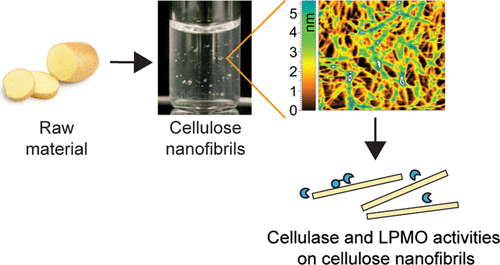当前位置:
X-MOL 学术
›
ACS Appl. Nano Mater.
›
论文详情
Our official English website, www.x-mol.net, welcomes your
feedback! (Note: you will need to create a separate account there.)
Cellulose Nanofibrils as Assay Substrates for Cellulases and Lytic Polysaccharide Monooxygenases
ACS Applied Nano Materials ( IF 5.3 ) Pub Date : 2020-06-22 , DOI: 10.1021/acsanm.0c01155 Alixander Perzon 1 , Benedikt M. Blossom 2 , Claus Felby 2 , Tina Jeoh 3 , Alex Hitomi 3 , Peter Ulvskov 1 , Bodil Jørgensen 1
ACS Applied Nano Materials ( IF 5.3 ) Pub Date : 2020-06-22 , DOI: 10.1021/acsanm.0c01155 Alixander Perzon 1 , Benedikt M. Blossom 2 , Claus Felby 2 , Tina Jeoh 3 , Alex Hitomi 3 , Peter Ulvskov 1 , Bodil Jørgensen 1
Affiliation

|
A facile method for preparing colloidal cellulose nanofibrils (CNFs) from potato tubers is presented comprising alkaline treatment to remove noncellulosic polysaccharides, followed by hypochlorite oxidation and homogenization. The CNF consisted of ∼94% cellulose, and carboxyl groups on the surface of CNF prevented their agglomeration. Aqueous suspensions of CNF had up to two times higher optical transparency than phosphoric acid swollen cellulose (PASC). The motivation for preparing CNF was to use it as a substrate for probing cellulose-degrading enzymes. It was shown that a lytic polysaccharide monooxygenase (LPMO) is active on CNF under formation of the same products as with other cellulose substrates. Moreover, CNF responded to cellulase treatment in a similar way to microcrystalline cellulose (Avicel), while PASC was rapidly broken down. Thus, a new assay substrate for these enzymes is presented with a unique combination of naturelike fibrillar structures and high optical transparency, which opens up for new types of analyses.
中文翻译:

纤维素纳米纤维作为纤维素酶和溶菌多糖单加氧酶的测定底物
提出了一种从马铃薯块茎制备胶体纤维素纳米原纤维(CNF)的简便方法,该方法包括碱处理以去除非纤维素多糖,然后进行次氯酸盐氧化和均质化。CNF由约94%的纤维素组成,CNF表面的羧基阻止了它们的团聚。CNF的水悬浮液的透光率是磷酸溶胀纤维素(PASC)的两倍。制备CNF的动机是将其用作探测纤维素降解酶的底物。结果表明,与其他纤维素底物形成的产物相同,裂解多糖单加氧酶(LPMO)在CNF上具有活性。此外,CNF对纤维素酶处理的反应类似于微晶纤维素(Avicel),而PASC则迅速分解。从而,
更新日期:2020-07-24
中文翻译:

纤维素纳米纤维作为纤维素酶和溶菌多糖单加氧酶的测定底物
提出了一种从马铃薯块茎制备胶体纤维素纳米原纤维(CNF)的简便方法,该方法包括碱处理以去除非纤维素多糖,然后进行次氯酸盐氧化和均质化。CNF由约94%的纤维素组成,CNF表面的羧基阻止了它们的团聚。CNF的水悬浮液的透光率是磷酸溶胀纤维素(PASC)的两倍。制备CNF的动机是将其用作探测纤维素降解酶的底物。结果表明,与其他纤维素底物形成的产物相同,裂解多糖单加氧酶(LPMO)在CNF上具有活性。此外,CNF对纤维素酶处理的反应类似于微晶纤维素(Avicel),而PASC则迅速分解。从而,











































 京公网安备 11010802027423号
京公网安备 11010802027423号